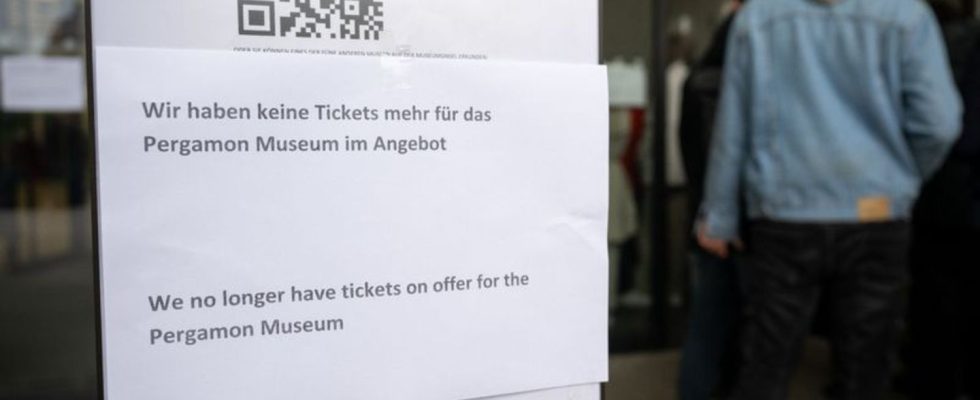Renovation
Pergamonmuseum before years of closure
“We no longer have tickets on offer for the Pergamon Museum”: From October 23rd, the doors to the museum will be completely closed for a few years. photo
© Sebastian Christoph Gollnow/dpa
Scaffolding has long been part of the Pergamon Museum, which is in need of renovation. Ancient gods attract more than a million people from all over the world to Berlin every year. Now it’s over for now.
The Pergamon Museum, one of the museum and tourist highlights on Berlin’s World Heritage-listed Museum Island, is facing closure for years. Due to extensive renovation work, treasures such as the colorful Ishtar Gate and the processional route of Babylon can only be seen until Sunday. The crowd has been correspondingly large for weeks.
“We no longer have tickets for the Pergamonmuseum on offer,” a sign at the entrance dashed many hopes. The time slots have been fully booked for a long time and people line up every day in front of the already busy place Museum queues. The opening hours have already been extended twice, and in the last few days the doors have remained open from 9 a.m. to 9 p.m.
The Pergamon Museum is one of the most popular German museums. It will remain completely closed for at least four years. The north wing of the building and the central wing with the famous Pergamon Altar have been without public access for ten years.
With the division into two construction phases, some parts were originally intended to remain accessible during the work. These plans were surprisingly thrown overboard in March by the responsible Prussian Cultural Heritage Foundation and the executive Federal Office for Building and Regional Planning.
Pergamon Altar should be accessible again in 2027
Construction section A with the Pergamon Altar, which has been closed since 2013, is scheduled to be accessible again in 2027. The altar dates from the 2nd century BC. It was part of the residence of the powerful kings of Pergamon, who created a cultural metropolis modeled on Athens in the west of what is now Turkey.
The second section B will remain closed from next Monday (October 23rd), Sunday is the last day for visits. The entire Pergamon Museum will not be open again until 14 years from now, in 2037. That’s the planning.
During the work, the immovable part of the artwork, which weighs tons, is equipped with sensitive sensors and protected from vibrations or moisture.
Three wings of the museum are currently grouped into a horseshoe around a courtyard, which will soon be accessible again via a bridge from Kupfergraben. As part of the work, a fourth, flatter wing will be created on the water side, which will then allow a complete tour of the ancient architecture for the first time.
The house, built between 1910 and 1930, is the dominant part of the Museum Island in the heart of the capital. The ensemble, consisting of five historical buildings, has been classified as a World Heritage Site by UNESCO since 1999 because of its special significance.
Total costs up to 1.5 billion euros
As one of the few museums in Germany, the Pergamon Museum, which includes the collection of antiquities, the Near Eastern Museum and the Museum of Islamic Art, attracts more than a million people every year. In the last year before Corona, there were still 804,000 visitors in 2019, despite closures due to construction.
The group of Pergamon Museum, Altes Museum, Bode Museum, Alter Nationalgalerie, Neues Museum, located between two arms of the Spree, with the famous Nefertiti and the James Simon Gallery as the most recent building, were visited by almost 3.1 million people before the pandemic.
The costs of the project in the listed building are enormous. The first part cost 489 million euros. 722.4 million euros are calculated for the second phase. Risks and price increases have so far amounted to 295.6 million euros. This means the total costs could reach 1.5 billion euros.
The Pergamon Museum is part of the master plan for the entire Museum Island ensemble. The planning for the extensive work extends well into – at least – the 2030s. Then an “archaeological promenade” will connect all the houses largely underground.

